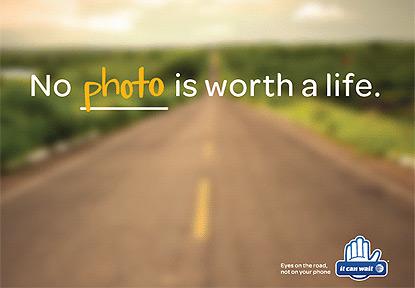
It’s
well-known that drivers shouldn’t be texting when behind the wheel. Nor should we be Web surfing, tweeting, taking selfies or really anything else that has to do with a smartphone.
Yet research shows drivers are still doing all of those things. Accordingly, AT&T is expanding its “It can wait” anti-texting and driving message to include all of the other
practices.
“The campaign's enduring message has not changed — it remains ‘It Can Wait.’ No text, post, email, video view or selfie is worth a
life,” Michelle Kuckelman, executive director integrated brand marketing at AT&T, tells Marketing Daily. “We are simply broadening the definition to include seemingly
innocent actions in the minds of drivers and make clear they are equally dangerous.”
advertisement
advertisement
A new awareness campaign appearing over the summer uses a blank space (filled in with
words such as “photo,” “e-mail” or “post) — in the sentence “no _____ is worth a life” to underscore the gravity of distracted driving. The campaign
icon of a hand raised in the form of a pledge (or making the sign for stop) remains.
“Our call to action is simple: Keep your eyes on the road, not on your phone,”
Kuckelman says. “We will bring this to life in compelling advertising and messaging that drivers can identify with so they may see their personal role in it, and make a change.”
The evolution comes on the heels of a new research commissioned by AT&T that found behind-the-wheel smartphone behavior had expanded to include social media (38%), Web surfing (28%),
selfies (17%) and video chatting (10%). Furthermore, 62% of drivers keep their smartphones within easy reach while driving.
To supplement the digital awareness campaigns,
AT&T is also launching a virtual reality interactive display that demonstrates the impossibility of using a smartphone while driving. Using equipment from Samsung, Google and Bose, the simulation
puts participants in a diver’s seat and introduces the everyday distractions — as well as smartphone distractions — to underscore the consequences of taking one’s focus from
the road, Kuckelman says.
“The experience culminates with a slow motion dramatization of the consequence of taking eyes off the road and hands off the wheel —
a crash or near miss caused by driver,” she says.
The VR simulator will make appearances at local events, schools and other “key sponsorship
properties,” to give people to immerse themselves and experience the risks firsthand.